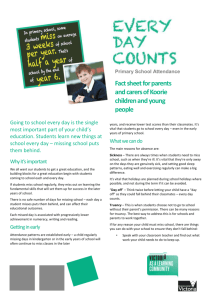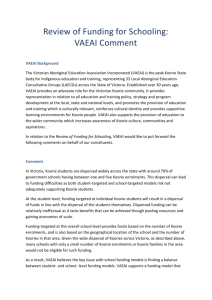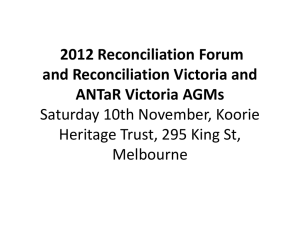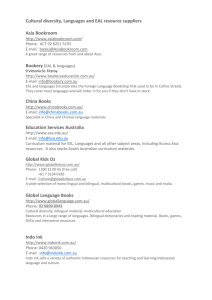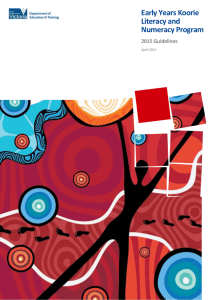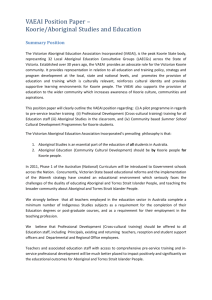Indigenous Youth Careers Pathway Program Discussion Paper
advertisement
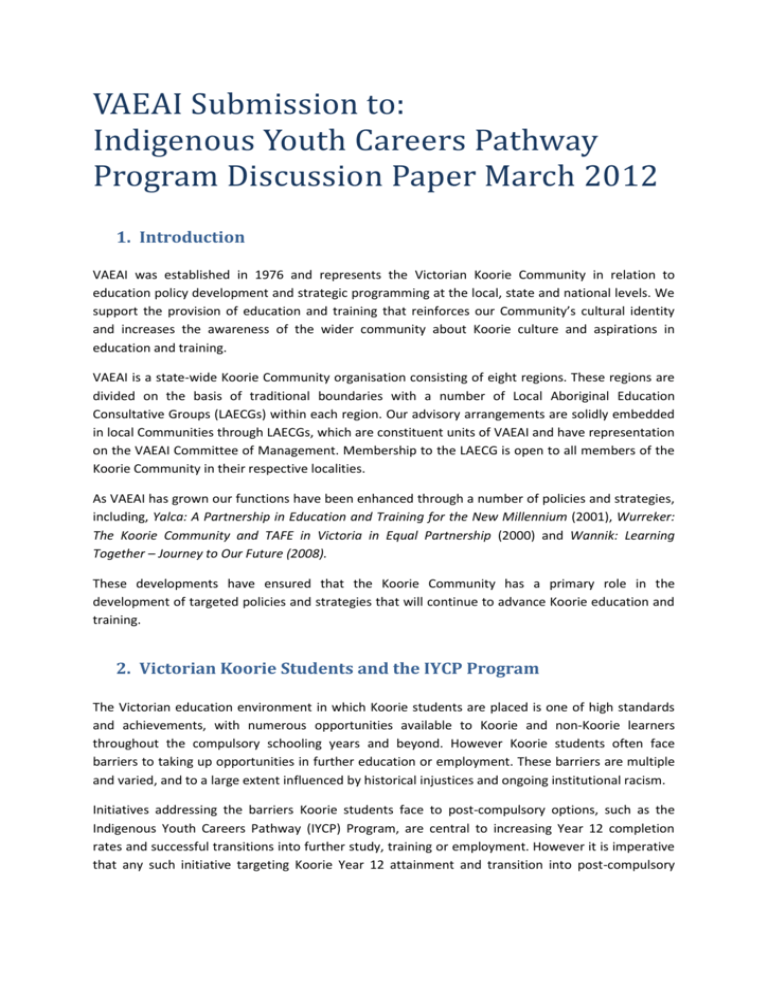
VAEAI Submission to: Indigenous Youth Careers Pathway Program Discussion Paper March 2012 1. Introduction VAEAI was established in 1976 and represents the Victorian Koorie Community in relation to education policy development and strategic programming at the local, state and national levels. We support the provision of education and training that reinforces our Community’s cultural identity and increases the awareness of the wider community about Koorie culture and aspirations in education and training. VAEAI is a state-wide Koorie Community organisation consisting of eight regions. These regions are divided on the basis of traditional boundaries with a number of Local Aboriginal Education Consultative Groups (LAECGs) within each region. Our advisory arrangements are solidly embedded in local Communities through LAECGs, which are constituent units of VAEAI and have representation on the VAEAI Committee of Management. Membership to the LAECG is open to all members of the Koorie Community in their respective localities. As VAEAI has grown our functions have been enhanced through a number of policies and strategies, including, Yalca: A Partnership in Education and Training for the New Millennium (2001), Wurreker: The Koorie Community and TAFE in Victoria in Equal Partnership (2000) and Wannik: Learning Together – Journey to Our Future (2008). These developments have ensured that the Koorie Community has a primary role in the development of targeted policies and strategies that will continue to advance Koorie education and training. 2. Victorian Koorie Students and the IYCP Program The Victorian education environment in which Koorie students are placed is one of high standards and achievements, with numerous opportunities available to Koorie and non-Koorie learners throughout the compulsory schooling years and beyond. However Koorie students often face barriers to taking up opportunities in further education or employment. These barriers are multiple and varied, and to a large extent influenced by historical injustices and ongoing institutional racism. Initiatives addressing the barriers Koorie students face to post-compulsory options, such as the Indigenous Youth Careers Pathway (IYCP) Program, are central to increasing Year 12 completion rates and successful transitions into further study, training or employment. However it is imperative that any such initiative targeting Koorie Year 12 attainment and transition into post-compulsory options, such as the IYCP Program, are sensitive to Koorie student educational and personal backgrounds, experiences and priorities. Koorie students in Victoria are widely dispersed geographically across the state, and across the government, catholic and independent schools sectors. Koorie students also come from a range of states, family and cultural backgrounds and educational experiences, all of which have led to the creation of a highly diverse body of students. Such dispersion and diversity is of concern with regard to the criteria for IYCP eligibility in that the IYCP framework ‘provides a new model that supports the needs of Aboriginal and Torres Strait Islander secondary school students in areas of disadvantage’. The provision of servicing Koorie students within areas of disadvantage is concerning given both the high dispersal rate of Koorie students in Victoria and the need to ensure post-compulsory pathways and transitions support is available to all students, not just those in recognised ‘areas of disadvantage’. As previously mentioned, Victorian Koorie students are part of a highly dispersed and diverse body that come from a range of backgrounds and geographical areas, not only areas of disadvantage. For example, with over 9,000 Koorie students in the 1,200 government schools in Victoria, over 75% of these schools have less than five Koorie students enrolled. Victoria does not have any areas classified as ‘remote’ and the majority of Koorie students are in metropolitan and regional centres. Therefore, support to Koorie students needs to be open and targeted to a wide array of educational backgrounds and needs, and should not be solely focused on a ‘deficit model’ in areas of disadvantage. Within the Victorian government schools sector, preliminary February 2012 census data reports that there are over 9,000 Koorie students enrolled from Year 1 to Year 12. Independent Schools Victoria reports the number of Koorie students at around 450 and the Catholic Education Office reports around 900 students. Student figures from Year 10 to Year 12 in the government schools sector for 2010 and 2011 are shown below: Year 2010 2011 Year 10 students 641.4 577.3 Year 11 students 580.8 533.9 Year 12 students 452 321.5 As this table shows, student numbers in the Victorian government schools sector have decreased across all higher secondary school years between 2010 and 2011. However these decreases can to a large extent be accounted for by correlating increases in Koorie student participation in the Vocational Education and Training (VET) sector. In 2010, Koorie enrollments in the VET sector were at 6,312, up from 5,285 in 2009. Preliminary 2011 data for government funded training places has the Koorie enrollment figure for students 17 years and under at 865, up from 730 in 2010. This is an increase of 135 school-aged students in government funded VET training, which largely aligns with the decrease of 130 Koorie students attending Year 12 between 2010 and 2011. This data aligns with anecdotal evidence received from the community that the Victorian government secondary school environment is in many cases not the education provider of choice for many older Koorie students. These students are instead choosing to move into the VET sector where they are able to specialise in a skill area, take on apprenticeship or traineeships, or work on foundation skills in a more flexible environment. The preference for many older Koorie students to participate in VET rather than in government secondary schools raises questions about whether the education environment in this sector is meeting their educational needs in a culturally appropriate way. It also raises concerns about the criteria of the IYCP Program for eligible students to ‘complete their formal education’. Whilst the importance of Year 12 attainment is significant, as shown by data on long-term employment stability, Koorie students should be entitled to choose alternate education providers, such as the VET sector, to provide their ‘formal education’. Ultimately, all students should be encouraged to complete Year 12 and move on to higher education and training pathways, and these students should be given all the support necessary to achieve this objective. Yet whilst the importance of improving Koorie student Year 12 retention and completion rates is high, it should be acknowledged that some Koorie students may not feel that the ‘traditional’ schooling environment meets their educational and cultural needs. These students have a real alternative option in alternative educational providers such as TAFEs, Registered Training Organisations and Adult and Community Education centres, which provide students with qualifications that are increasingly being acknowledged by employers and higher education providers. Students should not be asked to subscribe to a ‘one-size-fits-all’ mould, and in relation to pathways programs targeted at Koorie students, individual student needs and situations must be accounted for and incorporated into all stages of the transitions process. This kind of engagement is a critical component in improving education outcomes for Koorie students, and is inextricably linked to levels of connectedness to school, attendance and completion rates. 3. Response to IYCP Model Elements Discussion Points 1. School based traineeships What things should be taken into account when identifying traineeship places? Traineeship places should be located within the students’ community, and should match both student interests and available employment opportunities in the community. Group Training Organisations should be locally based organisations where possible. Providers of traineeships should have undertaken cultural awareness training. Traineeship places should be negotiated with the student to ensure they meet the students’ educational interests and needs. Schools need to ensure they provide the student with the necessary support and flexibility to undertake a school based traineeship. Trainees should be guaranteed employment upon completion of their traineeship, to ensure they do not become disengaged from the jobs market. 2. School based aspiration building events and activities What other activities could be provided to students to encourage them to complete their schooling and consider participating in a school based traineeship? Students and their families need to be consulted with to tailor events and activities, however a survey approach may not be the best method in some cases. Face-to-face conversations and group workshops should also be considered here. Expo’s, workshops and trainee ‘tasters’ should also highlight higher education options for Koorie students, not just training and employment. In Victoria the Koorie Big Day Out is a popular expo where Koorie students can meet with representatives from each of Victoria’s nine universities to find out information in their study options, scholarship and assistance. Engaging Koorie role models from a range of disciplines is important; academic, sporting, musicians, and professional role models each bring different perspectives and experiences and can connect with students on different levels. Local (Victorian) role models are preferred as role models for Koorie students where available as again this will likely lead to a stronger connection with students. In some cases, events and activities should consider being open to non-Koorie students who would also benefit, to ensure participation does not lead to stigmatism for Koorie students. It is important to build on initiatives that are already in place, rather than introducing new programs that lead to a doubling up of efforts and inefficiencies. Programs currently in place in Victoria that the IYCP Program could work with include The Aspirations Initiative (TAI), the Australian Indigenous Mentoring Experience (AIME), and the newly developed Koorie Academy of Excellence (KAE) in the Northern Metropolitan Region. 3. In-school and post-school mentoring Are there other mentoring activities that could be delivered in school or post school to enhance this element of the program? Again, it is important to build on initiatives already in place locally. With regard to mentoring these include TAI, AIME, the KAE as well as programs such as that offered by the Alpine School. Targeted careers counselling is an important element for Koorie students in Victoria as this service currently does not exist as a stand alone service in schools and has anecdotally been raised as a gap in Koorie-specific school support. Mentors must have completed cultural awareness training. Cultural activities or excursions. All activities should be scheduled for outside of school hours so that Koorie students are not taken out of the classroom and as a result miss out on standard lessons being undertaken by the rest of their class. 4. Support for employers What other support could be provided to employers to ensure the success of school based traineeships? Employers should have access to human resource support that is specifically geared towards assistance with Koorie employees. This kind of HR support is similarly crucial for Koorie employees themselves. Cultural awareness training for employers is required, and this training should also be extended to all employees of the organisation to ensure a safe and inclusive working environment for school based trainees and all employees. 5. Engaging with employment services and training providers What other activities with mainstream employment and training services could be provided to new school leavers to ensure they remain engaged with the labour market? All employment services and training providers should undertake cultural awareness training. New school leavers should be consulted with and actively involved in the engagement process with employment services and training providers to ensure their educational and personal needs are met. New school leavers should be able to access ongoing mentoring services once they are engaged in employment. New school leavers should be provided with continual opportunities for personal and professional development. New school leavers should have access to human resource support that is specifically geared towards assistance to Koorie employees. 4. Overview of key points Realise that Koorie students like all students in Victoria, come from a range of geographical and educational backgrounds and do not fit into a one-size-fits-all mould. Koorie students, like all students, should be encouraged to complete Year 12 and move on to higher education and training pathways, and should be given all the support necessary to achieve this objective. However it is equally important to acknowledge the prerogative of older secondary school Koorie students to choose to complete their education through an alternative training provider such as those offered by the VET sector. Pathways and transition assistance should be provided to all Koorie students, not just those identified as being in areas of disadvantage. Such a focus perpetuates the ‘deficit model’ of Koorie education that we are trying to move away from. Build on local initiatives already in place to ensure efficiency and economies of scale, rather than working in silos and doubled up efforts.
